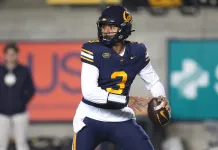Listening to handicapping professionals, and even the guys on ESPN’s “College GameDay,” you hear the term “revenge game” thrown around a lot, as if playing a team you lost to the previous season — or even earlier in the current season — is an automatic motivator.
Revenge will certainly be in focus this week as Alabama takes on Texas A&M. While the revenge angle might be somewhat valuable, and coaches surely play it up when given the chance, I can tell you in my 20%plussign% years handicapping college football, there’s very little I’ve found in terms of reliable angles involving revenge. That said, the last time I did a deep dive on the topic was about three years ago, and as always, things can and do change. With conference play starting in earnest last week, I figured this was a good time to go back through the database and study revenge.
I wanted to study only recent losses, as I think the motivation for avenging a defeat dissipates over time. Therefore, the only games I’m counting as “revenge games” in this report are when a team lost to an opponent in the previous season, or in some instances earlier that season (think conference championship games or College Football Playoff games). Anything beyond that means nothing in this study.
With that in mind, I prepared my database to look at all of the FBS revenge games over the last six-plus seasons (since the start of the 2016 season). I figured this would give us a large enough sample size, even for teams that lose only a game or two per season. My database sample size ended up being 2,894 games.
As a summary of what I found out in looking at these 2,894 games since 2016, teams in revenge mode have gone just 1,118-1,776 SU (38.6%) and 1,435-1,401-58 ATS (50.6%). Now clearly there’s no obvious strategy to play off of that data, as the teams in revenge mode are typically the lesser teams so it makes sense that they lose more games outright, and the point-spread advantage doesn’t cover the juice.
My first thought that came to mind is that better teams are probably better in revenge spots, and vice versa. I’ll look more closely at all of that later when I reveal eight different revenge betting systems that have worked fairly well in recent years, but for now, let’s look specifically at the team-by-team revenge records, sorted in order of ATS records.
Looking at the chart of FBS teams in revenge mode since 2016, one thing becomes quite obvious right off the bat: Some of the better and more consistent programs in recent years sport the best revenge records. Up until this season, Wisconsin (9-2 SU and 9-2 ATS in revenge mode) was a very consistent program that was disciplined and won games by playing its brand of football. We’ll see if that changes under interim coach Jim Leonhard. If you’re wondering, Wisconsin’s only revenge game this season is the finale against Minnesota at home. That game comes with plenty of motivation for both teams and often has Big Ten West Division title implications.
Alabama’s only scheduled revenge game this season comes this week against Texas A&M. The Tide are often outspoken about their vengeful mindset before games such as this, so I assume we’ll hear more before Saturday. In Alabama’s five revenge games since 2016, Nick Saban’s team is 5-0 SU and 4-1 ATS and has outscored the opposition 221-100.
(One key point: The data I captured does not include last week’s games, and one of the country’s top revenge teams added another win to its record when Utah took down Oregon State 42-16.)
Ohio State is among the worst revenge teams in recent years, although it’s a very small sample size as OSU rarely loses. Ryan Day’s team has avenged all three losses in the sample but only covered once (two of its revenge wins were one-point wins). Keep that in mind when Michigan travels to Columbus for the season finale.
Some other noteworthy teams on the bottom end of the revenge list include Appalachian State, Cincinnati, Boise State, Ole Miss, Iowa, Florida and Tennessee. The Volunteers are in the hunt for a CFP spot but have revenge games with Alabama and Georgia remaining.
Of the truly dreadful teams that rarely deserve your betting consideration, UMass has demonstrated little ability to avenge defeats, going 1-12 SU and 3-10 ATS in our sample. The Minutemen have three revenge spots left this season if you’re looking to fade them: Saturday against Liberty, Oct. 29 versus New Mexico State and Nov. 26 versus Army. The data did not capture UMass’ point-spread win against Eastern Michigan last week, however, so make the Minutemen 4-10 ATS since 2016.
Look for your favorite teams to bet on or against from the list and use these findings to help confirm your thoughts.
Revenge Betting Systems
One of the first things you’re going to want to understand is home teams in revenge spots have covered less than road and neutral-field teams over the last 6%plussign% seasons. This goes against any type of logical thinking. Here are the records by location for teams seeking revenge since 2016:
At home: 691-837 SU and 733-765-30 ATS (48.9%)
Neutral fields: 34-50 SU and 50-33-1 ATS (60.2%)
On the road: 393-889 SU and 652-603-27 ATS (52.0%)
As you can see, there is better than a 3% advantage against the spread for revenge teams playing on the road compared to at home. The edge for backing neutral-field teams is more than 11% higher. That leads us into our first revenge system.
1. Since the start of the 2016 season, neutral-field underdogs playing in revenge mode have gone 38-22 ATS (63.3%).
These are often teams playing in conference championship games or bowl games. Some major rivalry games are also on neutral fields. In all instances, the underdogs are usually sound teams that are motivated by both the revenge aspect and being underdogs.
2. Teams playing as huge underdogs at home in revenge games have been almost automatic covers, as those catching 30 points or more have gone 1-16 SU but 15-2 ATS (88.2%) in their last 17 games.
Whether it be the motivation of revenge, the fear of getting embarrassed at home or perhaps even the compassion of the far better road opponent, these revenge-minded home dogs compete better than expected. You have to figure that most of these revenge games are conference games, and there aren’t many cases where I’d lay 30%plussign% points with a road team in conference play.
3. Double-digit road favorites have been solid producers in the revenge role, going 42-28 ATS (60%) since 2016.
What type of teams wind up being double-digit road favorites in revenge games? Considering most of these games are conference games, usually the best teams in the country. Add the fuel of being motivated by revenge, and you usually see decisive victories.
4. Teams trying to avenge outright losses in which they were double-digit favorites have struggled, going just 71-93 ATS (43.3%) since 2016.
5. In a subset of No. 4, teams trying to avenge outright losses in which they were double-digit favorites, and that loss ruined an undefeated season at the time, have gone 7-20 ATS (25.9%).
These are two systems that go against the logic that better teams are better in revenge spots. They were double-digit favorites the last time out against the opponent but still lost outright. In the case of No. 5, it was a crushing loss that ruined a special season. These teams haven’t responded as expected.
6. Teams seeking revenge that have at least four more wins on the season than their opponent have been very successful, going 70-12 SU and 54-25-3 ATS (68.4%) since 2016.
The important thing to recognize in this system is we’re talking about the here and now. The team seeking revenge is having a much better season than the opponent they lost to the prior season. That is a perfect time to get revenge.
7. Better defensive teams are more successful in exacting revenge than prolific offensive teams. Since the start of the 2016 season, teams allowing 24 PPG or less have gone 489-436 ATS (52.9%). Those scoring 35 PPG or more have gone 308-339 ATS (47.6%).
These records don’t seem as definitive as the previous systems mentioned, but the point-spread variation between good defenses and good offenses is still over 5% and this is a much larger sample size. Shutting opponents down is a more essential ingredient in gaining revenge.
8. Teams seeking revenge against opponents allowing 35 PPG or more on the season have been very successful, going 188-140 ATS (57.3%) since 2016.
This one is pretty straightforward. For whatever reason, Team A lost to Team B last time out, most likely unexpectedly. Leading up to the revenge game, Team B is really struggling defensively. This is an ideal time to get revenge, and most often these teams win and cover.





